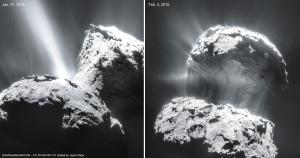Blog
Electric Avenue
7 June 2015
 ESA/Rosetta/NAVCAM, edited by Jason Major
ESA/Rosetta/NAVCAM, edited by Jason MajorComets are known for their tails. In the old days that’s how you distinguished a comet from an asteroid, though with our modern understanding the line between comet and asteroid as blurred a bit. Still, one of the big areas of comet research has been on just how comet tails and coma form.
The traditional view has been that water and other volatiles are ejected from the comet through sunlight. The ejected molecules are then broken up through a process of photoionization, where ultraviolet light strikes the molecules, causing them to break apart. It is these ionized molecules that we observe as the coma and tail of a comet.
But we now know that reactions in space can be much more complex and subtle. In this case, we now know that free electrons play a role in the breakup of ejected molecules. The work was recently published in Astronomy & Astrophysics, and details the role of electrons in the chemistry of cometary atmospheres.1 The data for this research came from the Rosetta probe orbiting Comet 67P/Churyumov-Gerasimenko. Using ultraviolet spectroscopy, the team found that rather than ionizing various molecules directly, the ultraviolet light liberates electrons from water molecules in the coma. These electrons then interact with other molecules to break them apart.
It’s a rather surprising result, but it’s also a great example of how better data allows us to refine a simple model into a more subtle and accurate one.
Feldman, Paul D., et al. “Measurements of the near-nucleus coma of comet 67P/Churyumov-Gerasimenko with the Alice far-ultraviolet spectrograph on Rosetta.” Astronomy & Astrophysics 583 (2015): A8. ↩︎